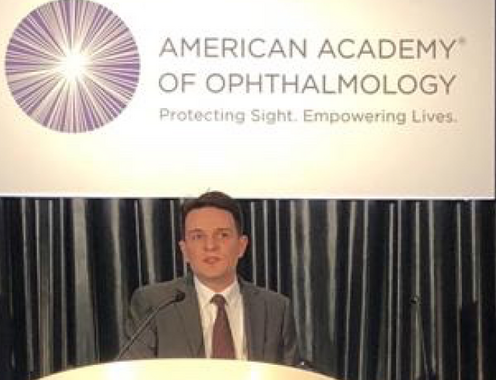“I am thrilled that Dr. Etienne Schönbach, who presented the Month 24 results from the Scotopic Microperimetric Assessment of Rod Function in Stargardt Disease (SMART) Study at the largest professional medical association of ophthalmologists in the United States, received this prestigious award on behalf of the study team,” said Hendrik Scholl, Clinical Director at IOB, and Principal Investigator of the study.
Shedding light on dark spots of unmet medical need
“The work of the international study team was to define useful outcome measures for clinical trials. The results show that in Stargardt disease type 1 (STGD1) scotopic macular function declines significantly faster than photopic loss. At the same time, both photopic and scotopic macular sensitivity shows statistically significant changes over time. This suggests - as Dr. Etienne Schönbach presented - that measuring rod function may indeed be the best way to detect the earliest functional change in STGD1. This is also a useful outcome measure for clinical trials,” Hendrik Scholl added.
Awarded work:
Month 24 Results from the Scotopic Microperimetric Assessment of Rod Function in Stargardt Disease (SMART) study.
Etienne Schonbach MD, Mohamed A Ibrahim Ahmed, MBBCH, Millena Gomes Bittencourt, MD, Rupert W Strauss, MD, Xiangrong Kong, Ann-Margret Ervin Alexander Ho, BS, Janet S Sunness MD, Isabelle Audo, David G Birch PhD, Michel Michaelides, MD, Sheila W West PhD, Michael S Ip MD, Srinivas R Sadda MD, Hendrik P Scholl, MD
About the SMART and ProgStar studies
SMART is an ancillary study to the international, multicenter, prospective Progression of Atrophy Secondary to Stargardt disease (ProgStar; www.ProgStar.org) study (NCT01977846) that aims to develop sensitive and reproducible surrogate outcome measures for clinical trials investigating the efficacy of emerging treatments for Stargardt disease with mutations in ABCA4 (STGD1).
SMART study results
The primary endpoints of SMART is the scotopic macular mean sensitivity of the macula and its changes over time. The test was performed over 24 months in 6-monthly intervals.
Dr. Schönbach presented that after an enrolment of 118 eyes (118 patients; mean age, 34.5±15 years), the baseline mean sensitivity was 11.5 dB (±5.1) for photopic (pMP) and 11.3 dB (±5.3) for scotopic testing (sMP). The yearly change was −0.63 dB/yr (P < .001) for pMP and −1.42 dB/yr (P < .001) for sMP. The count of normal test points decreased in both groups (pMP, −4.3%; sMP, −10.9%). Based on these results, the SMART investigators concluded that in STGD1, scotopic macular function declines significantly faster than photopic sensitivity.
At the same time, both photopic and scotopic macular sensitivity showed statistically significant changes over time. It was suggested that measuring rod function may be the best way to detect the earliest functional change in STGD1 and presents a useful outcome measure for clinical trials.
SMART study centers
The following clinical centers from www.ProgStar.org recruited for the ancillary SMART study:
1. Wilmer Eye Institute, Johns Hopkins University School of Medicine (Principal Investigator: Hendrik P. N. Scholl, MD, MA)
2. Greater Baltimore Medical Center (Principal Investigator: Janet S. Sunness, MD)
3. Moorfields Eye Hospital (Principal Investigator: Michel Michaelides, MBBS, FRCOphth)
4. Retina Foundation of the Southwest (Principal Investigator: David G. Birch, PhD)
5. Institut de la Vision (Principal Investigator: José A. Sahel, MD)
6. Universitäts-Augenklinik at Eberhard-Karls-Universität Tübingen (Principal Investigator: Eberhart Zrenner, MD, PhD)
7. The Doheny Image Reading Center at the David Geffen School of Medicine of UCLA (Medical Director of the reading center: Michael S. Ip, MD; President and Chief Scientific Officer of the Doheny Eye Institute: SriniVas R. Sadda, MD) served as the central reading center
8. The Dana Center for Preventive Ophthalmology at the Wilmer Eye Institute, Johns Hopkins University School of Medicine (Principal Investigators: Sheila K. West, PhD, and Xiangrong Kong, PhD) served as the central data coordinating center
Awarded presentation
The presentation of the month 24 results of SMART took place on Monday, October 14, 2019 at 3:15 pm during the Original Papers sessions at Moscone Center, San Francisco, California. The expert panel of retina specialists moderating the presentations named Dr. Schönbach’s paper as the one that they rated most highly.
Dr. Schönbach completed a clinical research fellowship in inherited retinal diseases with Prof. Hendrik Scholl at the Wilmer Eye Institute, Johns Hopkins University, where he dedicated time to the study of endpoints for clinical trials in degenerative retinal diseases. He is currently doing an ophthalmology residency at Case Western Reserve University (Cleveland, Ohio).
Original papers
Scotopic Microperimetric Assessment of Rod Function in Stargardt Disease (SMART) Study: Design and Baseline Characteristics (Report No. 1).
Strauss RW, Kong X, Bittencourt MG, Ho A, Jha A, Schönbach EM, Ahmed MI, Muñoz B, Ervin AM, Michaelides M, Birch DG, Sahel JA, Sunness JS, Zrenner E, Bagheri S, Ip M, Sadda S, West S, Scholl HPN; for the SMART Study Group. Ophthalmic Res. 2019;61(1):36-43. doi: 10.1159/000488711. Epub 2018 Jun 25.
Macular Sensitivity Measured With Microperimetry in Stargardt Disease in the Progression of Atrophy Secondary to Stargardt Disease (ProgStar) Study: Report No. 7.
Schönbach EM, Wolfson Y, Strauss RW, Ibrahim MA, Kong X, Muñoz B, Birch DG, Cideciyan AV, Hahn GA, Nittala M, Sunness JS, Sadda SR, West SK, Scholl HPN; ProgStar Study Group. JAMA Ophthalmol. 2017 Jul 1;135(7):696-703. doi: 10.1001/jamaophthalmol.2017.1162.
About the AAO
The American Academy of Ophthalmology is the largest professional medical association of ophthalmologists in the United States. More than 32,000 medical doctors and more than 90 percent of practicing ophthalmologists in the United States are members. Their 2019 annual meeting took place on October 12 to 15, 2019, in San Francisco, California.

